When you purchase through links on our site, we may earn an affiliate commission. Here’s how it works.
While Starlink satellites consistently make headlines, there are plenty of weird facts about Starlink that fly below the radar.
SpaceX’s Starlink satellites are among the most well-known spacecraft in the world.
There are currently over 3,000 Starlink satellites in orbit, and SpaceX plans to launch many more. The satellites are primarily designed to provide broadband internet to remote or underserved locations, yet there are many other uses for the revolutionary constellation both planned and already in use.
While Starlink satellites consistently make headlines for the sheer number of launches SpaceX performs each year, not to mention the impacts the satellites have had on astronomy and Russia’s invasion of Ukraine, there are plenty of weird facts about Starlink that fly below the radar.
Related: Starlink satellites: Everything you need to know
The novel follows 16-year-old Hazel Lancaster, who has been diagnosed with terminal cancer. At a cancer support group, Hazel meets another teenager with cancer, Augustus, and the two fall in love. The novel drives home the fact that while emotional pain is a constant of the human existence, we at least have the choice of who we share that pain with.
Read more: SpaceX Starlink satellites to beam service straight to smartphones
If anyone is curious, the name was inspired by The Fault in Our StarsFebruary 21, 2018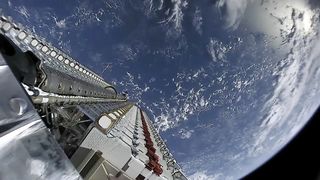
Linux (opens in new tab) was created in 1991 by Linus Torvalds, a Finnish software engineer, in order to be a free, openly-shared operating system that could be tailored for users’ specific computer hardware.
By its very design, Linux is easy to customize, making it ideal for specific use cases like Starlink satellites. In addition, Linux-based operating systems can draw upon a worldwide repository of open-source programs and tools, enabling rapid prototyping of new hardware and software.
Read more: SpaceX raises launch and Starlink prices, citing inflation
First-generation Starlink satellites weigh 573 lbs (259 kg), while Starlink 2.0 weigh in at 2,755 lb (1250 kg), Musk told Everyday Astronaut’s Tim Dodd (opens in new tab).
To loft these larger Starlinks to orbit, SpaceX will eventually begin using Starship, its huge new Mars and moon rocket. Starship is still under development, but SpaceX is planning an orbital test soon.
Read more: SpaceX aims to start launching next-gen Starlink satellites this month: report
This allows Starlink satellites within a constellations to share data among themselves, reducing the reliance on ground stations. These laser links allow internet traffic to be shared from satellite to satellite around the world, avoiding the need to relay the signals to a ground-based internet network.
The laser crosslinks allow Starlink constellations to beam internet connectivity to the most remote locations, including polar regions.
Read more: SpaceX paused Starlink launches to give its internet satellites lasers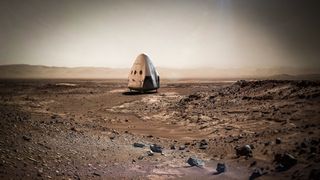
“For Services provided on Mars, or in transit to Mars via Starship or other spacecraft, the parties recognize Mars as a free planet and that no Earth-based government has authority or sovereignty over Martian activities,” the Starlink terms of service read. “Accordingly, Disputes will be settled through self-governing principles, established in good faith, at the time of Martian settlement.”
SpaceX has plans to place humans on the Red Planet by the end of the decade, according to comments made by company leadership.
Read more: Humanity will go to Mars ‘in this decade,’ SpaceX president predicts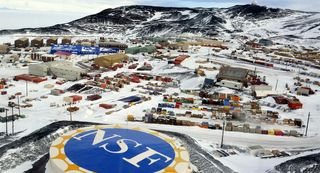
Scientists with the United States Antarctic Program (USAP) have tested at the McMurdo Station research outpost. “NSF-supported USAP scientists in #Antarctica are over the moon! Starlink is testing polar service with a newly deployed user terminal at McMurdo Station, increasing bandwidth and connectivity for science support,” the U.S. National Science Foundation stated via Twitter (opens in new tab) in September 2021.
SpaceX began lofting satellites into polar orbit in September 2021 with its first West Coast launch at Vandenberg Space Force Base in California. “These polar launches will enable complete coverage of Earth (where approved by local government),” Musk tweeted in July 2022 (opens in new tab).
Read more: SpaceX’s Starlink internet service reaches Antarctica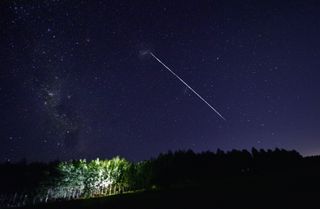
On numerous occasions, these Starlink trains have been mistaken for UFOs (opens in new tab) and have generated headlines (opens in new tab) as local news stations receive floods of calls from startled skywatchers.
Aside from being mistaken for UFOs, these sightings present another worrisome issue: Ruining the dark sky conditions necessary for astronomy. The International Astronomical Union has even implored the United Nations to take steps to protect the night sky from Starlink constellations.
Read more: No, they’re not aliens — SpaceX’s Starlink satellites surprise British skywatchers
Starlink has been used extensively by Ukrainian forces during Russia’s ongoing invasion of Ukraine, but the United States military has also eyed its own uses for Starlink. In 2020, the U.S. Air Force and SpaceX teamed up for a live-fire exercise (opens in new tab) in which Starlink satellites shared data with U.S. military assets that shot down a drone and a cruise missile.
SpaceX has since created a Starlink partner project called Starshield that will cater exclusively to the United States military and associated agencies. Starshield will offer a higher level of security than Starlink, featuring “additional high-assurance cryptographic capability to host classified payloads and process data securely, meeting the most demanding government requirements,” according to SpaceX’s Starshield page (opens in new tab).
Read more: SpaceX reveals ‘Starshield’ satellite project for national security use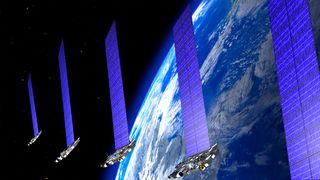
However, a team of researchers at the University of Texas at Austin found a way to do just that in October 2022 by reverse-engineering Starlink signals (opens in new tab). They found that the repeating beacon signals from Starlink constellations, designed to help receivers on the ground connect with satellites, could be used to form a navigation system.
“It’s a framework that is so general we can apply it to any terrestrial or extraterrestrial signal,” UT Austin’s Todd Humphreys told the MIT Technology Review (opens in new tab). “It will learn on the fly, tell you what is being transmitted, and tell you where you are.”
Read more: Elon Musk says Russia is ramping up cyberattacks on SpaceX’s Starlink systems in Ukraine
In fact, one team of Chinese researchers at the Northwest Institute of Nuclear Technology, a research institute run by the People’s Liberation Army, recently published a paper discussing ways to destroy or disable Starlink. Their solution? Detonating a nuclear weapon in space.
According to the South China Morning Post (opens in new tab) (SCMP), the researchers suggested that a 10-megaton nuclear explosion would be powerful enough to d “The strong residual radiation of the debris cloud may cause failures of spacecraft moving in it, such as satellites, or even cause direct damage that can lead to destruction,” the researchers wrote in a publication in the Chinese journal Nuclear Techniques, reported SCMP.
Read more: Chinese scientists call for plan to destroy Elon Musk’s Starlink satellites
Follow Brett on Twitter at @bretttingley. Follow us on Twitter @Spacedotcom or on Facebook.
Join our Space Forums to keep talking space on the latest missions, night sky and more! And if you have a news tip, correction or comment, let us know at: community@space.com.
Brett is a science and technology journalist who is curious about emerging concepts in spaceflight and aerospace, alternative launch concepts, anti-satellite technologies, and uncrewed systems. Brett’s work has appeared on The War Zone at TheDrive.com, Popular Science, the History Channel, Science Discovery, and more. Brett has English degrees from Clemson University and the University of North Carolina at Charlotte. In his free time, Brett is a working musician, a hobbyist electronics engineer and cosplayer, an avid LEGO fan, and enjoys hiking and camping throughout the Appalachian Mountains with his wife and two children.
Space is part of Future US Inc, an international media group and leading digital publisher. Visit our corporate site (opens in new tab).
© Future US, Inc. Full 7th Floor, 130 West 42nd Street, New York, NY 10036.